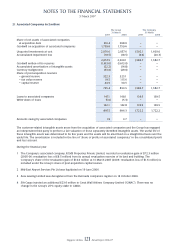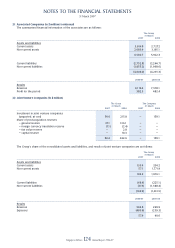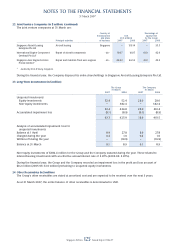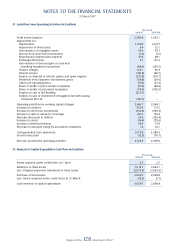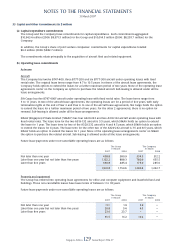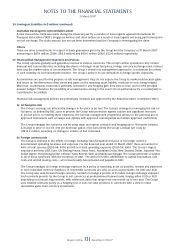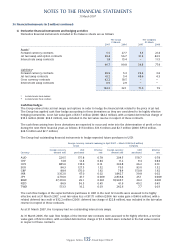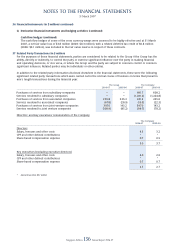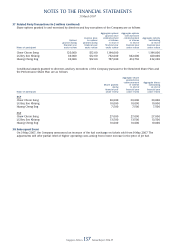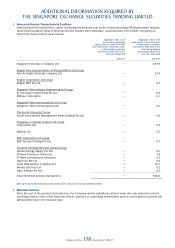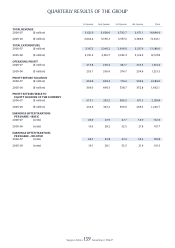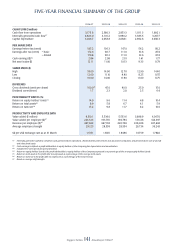Singapore Airlines 2007 Annual Report Download - page 133
Download and view the complete annual report
Please find page 133 of the 2007 Singapore Airlines annual report below. You can navigate through the pages in the report by either clicking on the pages listed below, or by using the keyword search tool below to find specific information within the annual report.NOTES TO THE FINANCIAL STATEMENTS
31 March 2007
Singapore Airlines 131 Annual Report 2006-07
34 Contingent Liabilities (in $ million) (continued)
Australian travel agent’s representative action
A new class action claim was made during the fi nancial year by a number of travel agents against International Air
Transport Association (“IATA”), Singapore Airlines and other airlines as a result of travel agents not being paid commission
on fuel surcharge. The claim amount has not yet been determined and the Company is investigating the claim.
Others
There are other commitments in respect of bank guarantees given by the Group and the Company at 31 March 2007
amounting to $87.9 million (2006: $58.9 million) and $60.6 million (2006: $22.6 million) respectively.
35 Financial Risk Management Objectives and Policies
The Group operates globally and generates revenue in various currencies. The Group’s airline operations carry certain
fi nancial and commodity risks, including the effects of changes in jet fuel prices, foreign currency exchange rates, interest
rates and the market value of its investments. The Group’s overall risk management approach is to moderate the effects
of such volatility on its fi nancial performance. The Group’s policy is to use derivatives to hedge specifi c exposures.
As derivatives are used for the purpose of risk management, they do not expose the Group to market risk because gains
and losses on the derivatives offset losses and gains on the matching asset, liability, revenues or costs being hedged.
Moreover, counterparty credit risk is generally restricted to any hedging gain from time to time, and not the principal
amount hedged. Therefore the possibility of a material loss arising in the event of non-performance by a counterparty is
considered to be unlikely.
Financial risk management policies are periodically reviewed and approved by the Board Executive Committee (“BEC”).
(a) Jet fuel price risk
The Group’s earnings are affected by changes in the price of jet fuel. The Group’s strategy for managing the risk on
fuel price, as defi ned by BEC, aims to provide the Group with protection against sudden and signifi cant increases
in jet fuel prices. In meeting these objectives, the fuel risk management programme allows for the judicious use of
approved instruments such as swaps and options with approved counterparties and within approved credit limits.
The Group manages this fuel price risk by using swap and option contracts and hedging up to 18 months forward.
A change in price of one US cent per American gallon of jet fuel affects the Group’s annual fuel costs by
US$15.2 million, assuming no change in volume of fuel consumed.
(b) Foreign currency risk
The Group is exposed to the effects of foreign exchange rate fl uctuations because of its foreign currency
denominated operating revenues and expenses. For the fi nancial year ended 31 March 2007, these accounted for
66% of total revenue (2005-06: 65%) and 65% of total operating expenses (2005-06: 69%). The Group’s largest
exposures are from USD, Euro, UK Sterling Pound, Swiss Franc, Australian Dollar, New Zealand Dollar, Japanese Yen,
Indian Rupee, Hong Kong Dollar, Chinese Yuan, Korean Won and Malaysian Ringgit. The Group generates a surplus
in all of these currencies, with the exception of USD. The defi cit in USD is attributable to capital expenditure, fuel
costs and aircraft leasing costs – all conventionally denominated and payable in USD.
The Group manages its foreign exchange exposure by a policy of matching, as far as possible, receipts and payments
in each individual currency. Surpluses of convertible currencies are sold, as soon as practicable, for USD and SGD.
The Group also uses forward foreign currency contracts to hedge a portion of its future foreign exchange exposure.
Such contracts provide for the Group to sell currencies at predetermined forward rates, buying either USD or SGD
depending on forecast requirements, with settlement dates that range from one month up to one year. The Group
uses forward contracts purely as a hedging tool. It does not take positions in currencies with a view to make
speculative gains from currency movements.


